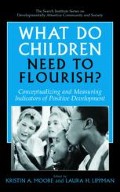Access this chapter
Tax calculation will be finalised at checkout
Purchases are for personal use only
Preview
Unable to display preview. Download preview PDF.
References
Achenbach, T. M. (1991). Manual for the Child Behavior Checklist/4-18 and 1991 profile. Burlington: University of Vermont, Department of Psychiatry.
Brody, G. H. (1998). Sibling relationship quality: Its causes and consequences. Annual Review of Psychology, 49, 1–24.
Brody, G. H., & Murry V. M. (2001). Sibling socialization of competence in rural, single-parent African American families. Journal of Marriage and Family, 63, 996–1008.
Brody, G. H., Stoneman, Z., Smith, T., & Gibson, N. M. (1999). Sibling relationships in rural African American families. Journal of Marriage and Family, 61, 1046–1057.
Buhrmester, D., & Furman, W. (1990). Perceptions of sibling relationships during middle childhood and adolescence. Child Development, 61, 1387–1398.
Cole, A. K., & Kearns, K. A. (2001). Perceptions of sibling qualities and activities of early adolescents. Journal of Early Adolescence, 21, 204–227.
Conger, K. J., Conger, R. D., & Scaramella, L. V. (1997). Parents, siblings, psychological control and adolescent adjustment. Journal of Adolescent Research, 12, 113–138.
Dunn, J., & Munn, P. (1985). Becoming a family member: Family conflict and the development of social understanding in the second year. Child Development, 56, 480–492.
Furman, W., & Buhrmester, D. (1985). Children’s perceptions of the qualities of sibling relationships. Child Development, 56, 448–461.
Garcia, M. M, Shaw, D. S., Winslow, E. B., & Yaggi, K. E. (2000). Destructive sibling conflict and the development of conduct problems in young boys. Developmental Psychology, 36, 44–53.
Graham-Bermann, S. A., & Cutler, S. E. (1994). The Brother-Sister Questionnaire: Psychometric assessment and discrimination of well-functioning from dysfunctional relationships. Journal of Family Psychology, 8, 224–238.
Herrera, C, & Dunn, J. (1997). Early experiences with family conflict: Implications for arguments with a close friend. Developmental Psychology, 33, 869–881.
Hetherington, E. M., & Clingempeel, W. G. (1992). Coping with marital transitions: A family systems approach. Monographs of the Society for Research in Child Development, 57 (2–3, Serial No. 227).
Hetherington, E. M., Henderson, S. H., Reiss, D. (1999). Adolescent siblings in stepfamilies: Family functioning and adolescent adjustment. Monographs of the Society for Research in Child Development, 64(4), 222.
Howe, N. (1991). Sibling-directed internal state language, perspective-taking and affective behavior. Child Development, 62, 1503–1512.
Howe, N., Aquan-Assee, J., & Bukowski, W. M. (1995). Self-disclosure and the sibling relationship: What did Romulus tell Remus? In K. J. Rotenberg (Ed.), Disclosure processes in children and adolescents (pp. 78–99). Cambridge: Cambridge University Press.
Howe, N., Aquan-Assee, J. Bukowski, W. M., Lehoux, P. M., & Rinaldi, C. M. (2001). Siblings as confidants: Emotional understanding, relationship warmth, and sibling self-disclosure. Social Development, 10, 439–454.
Kramer, L., & Baron, L. A. (1995). Parental perceptions of children’s sibling relationships. Family Relations, 44, 95–103.
McElwain, N. L., & Volling, B. L. (2002). Relating individual control, social understanding, and gender to child-friend interaction: A relationships perspective. Social Development, 11, 362–385.
Mendelson, M. J., Aboud, F. E., & Lanthier, R. P. (1994). Kindergartners’ relationships with siblings, peers, and friends. Merrill-Palmer Quarterly, 40(3), 416–435.
Riggio, H. R. (2000). Measuring attitudes toward adult sibling relationships: The Lifespan Sibling Relationship Scale. Journal of Social and Personal Relationships, 17(6), 707–728.
Schaefer, E. S., & Edgerton, M. (1981). The Sibling Inventory of Behavior. Chapel Hill: University of North Carolina.
Stocker, C. M., Lanthier, R. P., & Furman, W. (1997). Sibling relationships in early adulthood. Journal of Family Psychology, 11(2), 210–221.
Stocker, C. M., & McHale, S. M. (1992). The nature and family correlates of preadolescents’ perceptions of their sibling relationships. Journal of Social and Personal Relationships, 9, 179–195.
Stormshak, E. A., Bellanti, C. J., Bierman, K. L., & Conduct Problems Prevention Research Group. (1996). The quality of sibling relationships and the development of social competence and behavioral control in aggressive children. Developmental Psychology, 32, 79–89.
Taylor, R. J., Chatters, L. M., & Mays, V. M. (1988). Parents, children, siblings, in-laws, and non-kin as sources of emergency assistance to black Americans. Family Relations, 37, 298–304.
Volling, B. L. (2003). Sibling relationships. In M. H. Bornstein, L. Davidson, C. L. M. Keyes, K. A. Moore, & the Center for Child Well-being (Eds.), Well-being: Positive development across the life course (pp. 205–220). Mahwah, NJ: Lawrence Erlbaum.
Volling, B. L., & Elins, J. (1998). Family relationships and children’s emotional adjustments as correlates of maternal and paternal differential treatment: A replication with toddler and preschool siblings. Child Development, 63, 1209–1222.
Volling, B. L., McElwain, N. L., & Miller, A. L. (2002). Emotion regulation in context: The jealousy complex between young siblings and its relations with child and family characteristics. Child Development, 73, 581–600.
Widmer, E. D., & Weiss, C. C. (2000). Do older siblings make a difference? The effects of older sibling support and older sibling adjustment on the adjustment of socially disadvantaged adolescents. Journal of Research on Adolescence, 10, 1–27.
Youngblade, L. M., & Dunn, J. (1995). Individual differences in young children’s pretend play with mother and sibling: Links to relationships and understanding of other people’s feelings and beliefs. Child Development, 66, 1472–1492.
Author information
Authors and Affiliations
Editor information
Editors and Affiliations
Rights and permissions
Copyright information
© 2005 Springer Science+Business Media
About this chapter
Cite this chapter
Volling, B.L., Blandon, A.Y. (2005). Positive Indicators of Sibling Relationship Quality: The Sibling Inventory of Behavior. In: Moore, K.A., Lippman, L.H. (eds) What Do Children Need to Flourish?. The Search Institute Series on Developmentally Attentive Community and Society, vol 3. Springer, Boston, MA . https://doi.org/10.1007/0-387-23823-9_13
Download citation
DOI: https://doi.org/10.1007/0-387-23823-9_13
Publisher Name: Springer, Boston, MA
Print ISBN: 978-0-387-23061-0
Online ISBN: 978-0-387-23823-4
eBook Packages: Behavioral ScienceBehavioral Science and Psychology (R0)

